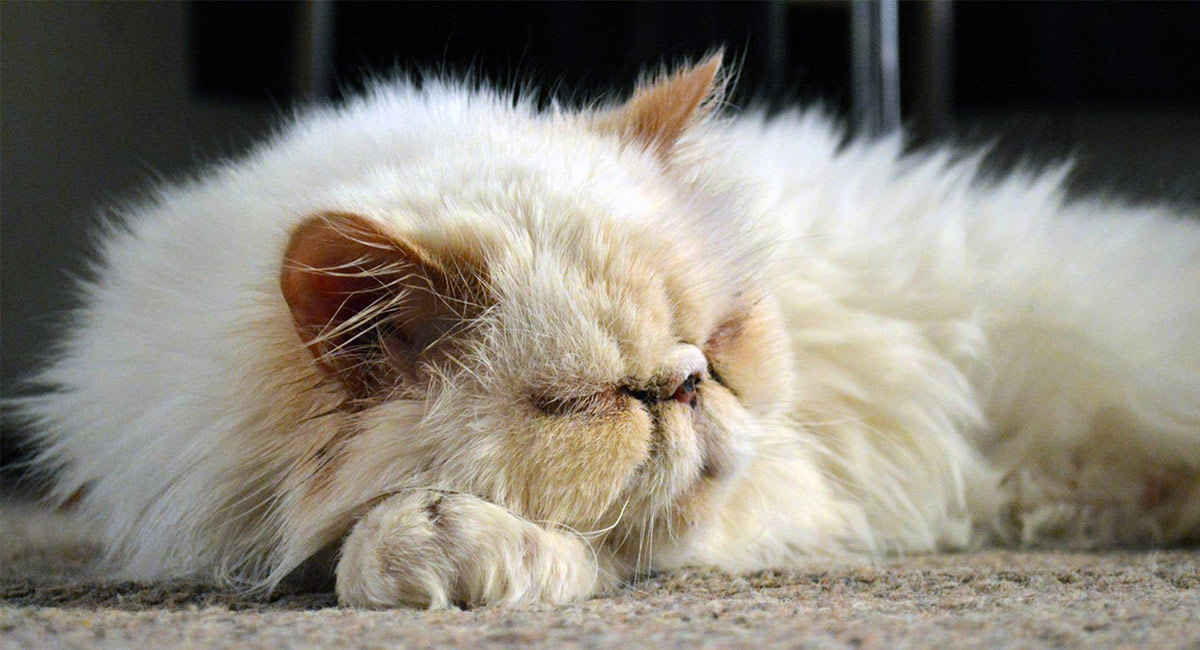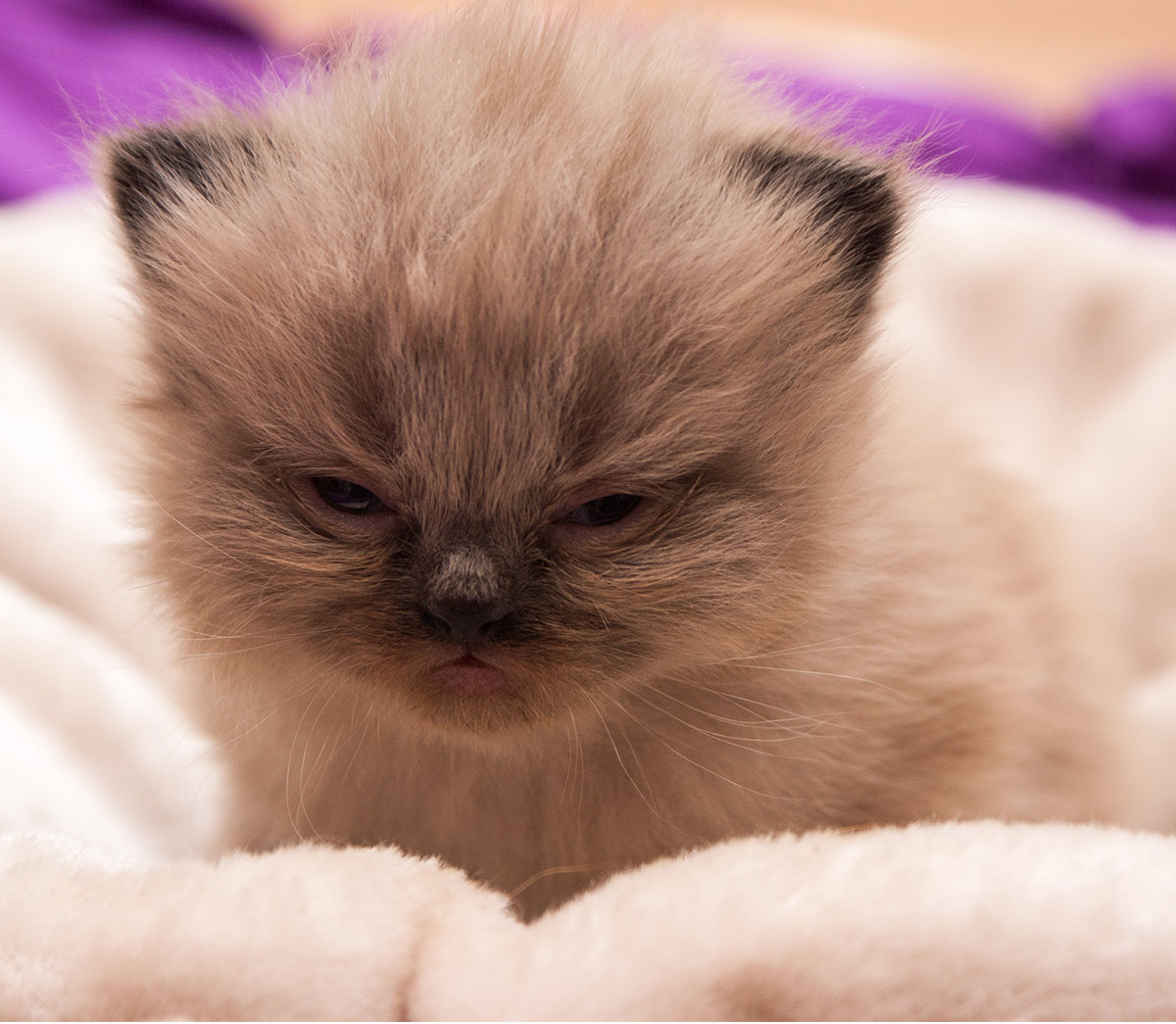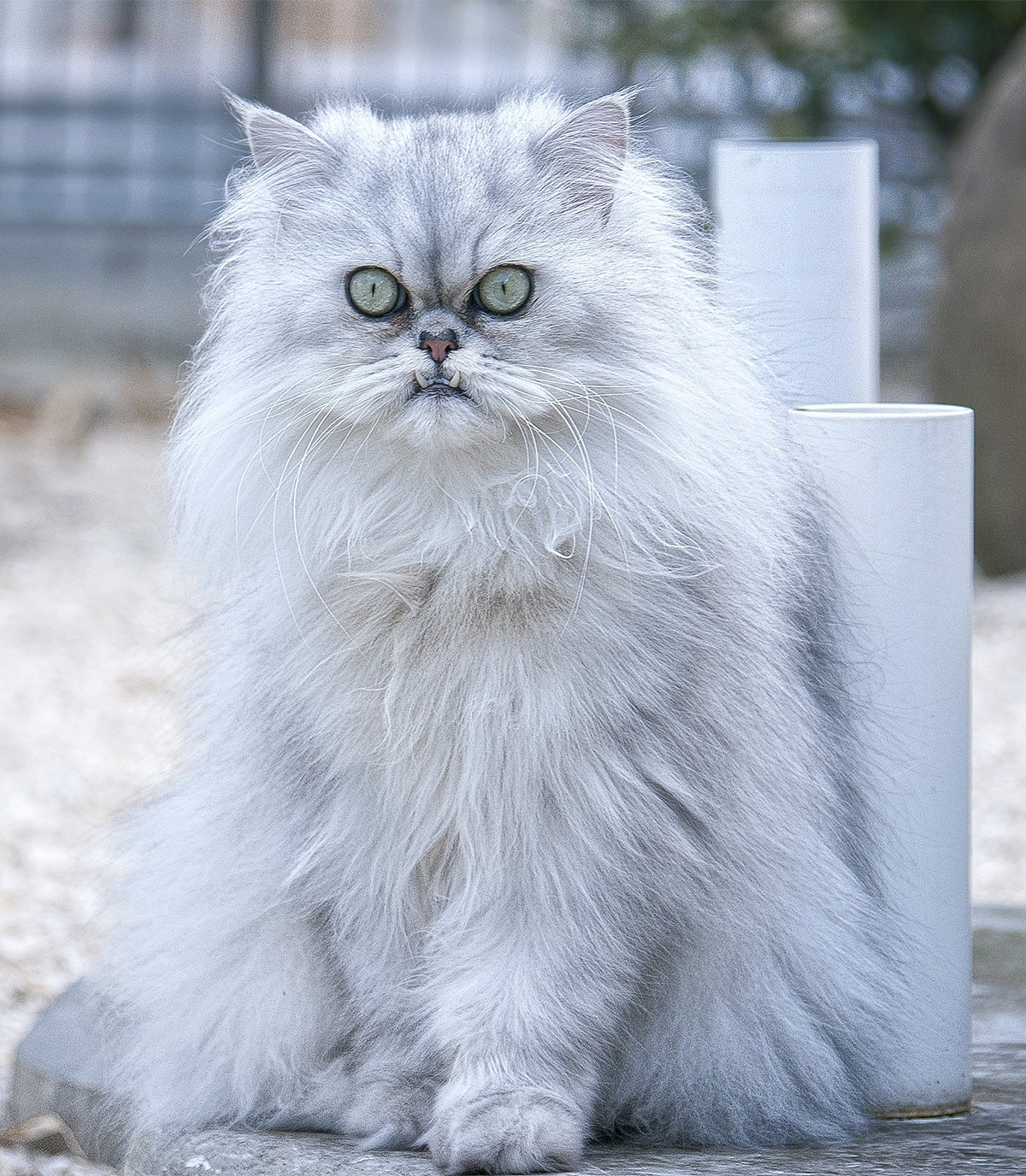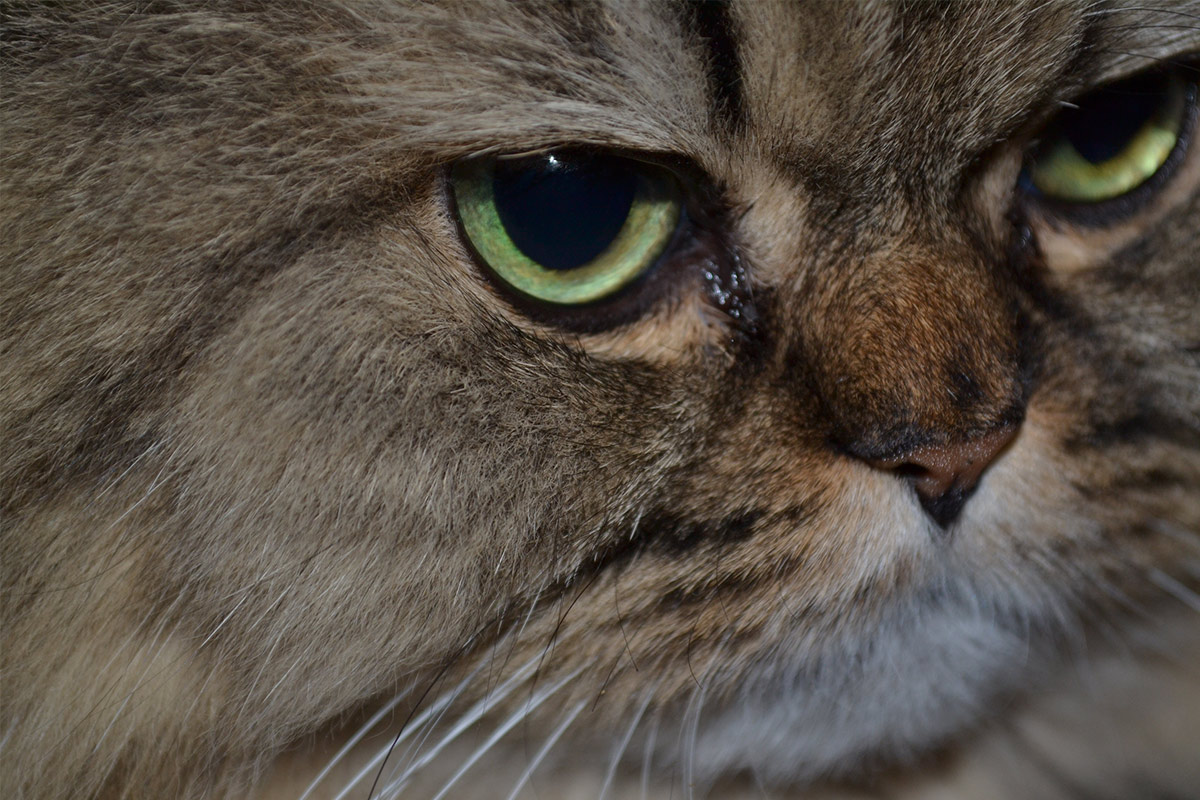
Flat faced cats are widely admired for their squashed features. Their muzzle is short, nostrils are narrowed and the bridge of their nose often has a raised ridge of skin above it. Flat faced cat breeds include the popular Persians, Scottish Folds and Exotic Shorthair. Flat faced cat breeds are famous for their grumpy cat face, sad eyes and appealingly baby-like expressions. But sadly flat faced cats have big healthy problems.
The condition of the shortened skull which causes their distinctive look is called Brachycephaly. Symptoms of the facial features this causes also include difficulty breathing, respiratory infections, dental disorders and eye problems. Flat faced cats also have trouble giving birth, increased risks under anesthetic, sleep disorders and even temperature control issues.
Contents
Flat Faced Cat Breeds
Veterinary and scientific research professionals have identified the Persian,Exotic Shorthair and Himalayan cat breeds as brachycephalic. But the problem also potentially affects the Scottish Fold, Burmese and British Shorthair to a lesser or greater degree. And some believe the Selkirk Rex is being pushed in the same direction.
What Is Brachycephaly?
Brachycephaly is the scientific term for flat faces. It means ‘short skull’. The skulls of brachycephalic animals grow to a normal width. But the distance from the back of their head to the tip of their nose is stunted.
In fact brachycephaly in dogs is quite well known these days. There is a large and expanding archive of research about them. As well as increasing public awareness.
Brachycephalic cats suffer in the same ways. But they haven’t been studied as extensively yet. So people are generally less likely to realise they have the same problems.

Health Problems Of Flat Faced Cats
The health problems of flat faced cats can be broadly categorised as:
We’ll look at each of these more closely now.
1. Breathing Problems In Flat Faced Cats
Breathing trouble experienced by flat faced cats can range from quite minor to very serious indeed.

The extent of their breathing problems is directly related to the extent of their brachycephaly.
The shorter their skull, the worse their breathing.
The reason for this are:
i. Too much tissue
Although a brachycephalic cat’s skull is shorter than it should be, all the tissues that usually fit inside a cat’s mouth remain regular cat size.
And there just isn’t room for them.
ii. Closed nostrils
A common result of brachycephaly is that the facial features become smooshed together and bunched up.
This bunching up pushes the opening of the nostril. So the space for air to enter becomes narrow and constricted.
The veterinary term for this is stenotic nares.
iii. Elongation of the soft palate
The soft palate is the group of muscles at the back of the roof of the mouth. Their function is to close off the airway when cats swallow.
In flat faced cats, the soft palate – whilst normal sized – can be too long for the abnormally short space inside their skull.
Instead of closing of the airway appropriately, the soft palate permanently blocks it, and stops the free flow of air.
There is even one recorded case of an elongated palate causing fluid to build up in the lungs of a young Persian cat.
The Consequences Of Airway Obstruction In Flat Faced Cats
These three factors, combined with others, can have dangerous consequences for cats’ health.

Structures called turbinates, which should fit above their nose, end up protruding into the cavity at the back of the mouth. This restricts airflow and is linked to respiratory tract infections.
Brachycephalic airway syndrome is also linked to laryngeal collapse, which is potentially fatal.
Constricted airways also make it harder for a vet to intubate your cat quickly and safely should they need surgery. But we’ll come to other complications of surgery in a moment.
Brachycephalic Airway Syndrome
Brachycephalic airway syndrome is the collective name for all of the breathing problems above, when a flat face causes an animal’s airways to be obstructed.
Research into brachycephalic airway syndrome in cats is not comprehensive.
But fortunately there is some. And we can infer a little more from work with dogs.
Simply put, they have a lot of breathing problems.
Cats with brachycephalic airway syndrome are at increased risk of:
- sleep apnea
- upper respiratory tract infections
- and invasive fungal lung infections.
Treating Breathing Problems In Flat Faced Cat Breeds
Surgeries to remove excess tissue, reduce an elongated palate, and widen stenotic nares are all used to improve breathing of cats badly affected by brachycephalic airway syndrome.
Since stenotic nares (narrow nostrils) are a very common feature of flat faced cats, and the procedure to widen them is the least invasive, it is one of the most commonly performed.

During surgery, a vet removes small wedges of the dorsolateral cartilage which supports the outside edge of the nostril. This creates more space for airflow.
Some adult flat faced cats that appear to have good nostrils may owe them to surgery at an earlier point in their life.
It’s important to know this if you are considering buying a flat faced kitten. Since you are likely to end up footing the same vet bill further down the line.
Never buy a kitten from a parent that has needed surgery in order to breathe freely. And always get your cat checked by a qualified vet if they are breathing heavily without any obvious reason.
2. Eye Problems of Flat Faced Cats
But the head shape of these cats affects more than just breathing.
They also suffer well documented problems with their eyes.
Brachycephalic cats’ eyes protrude further than usual from their socket. This is due to lack of space in their shortened skulls.
Eyes are not designed to sit outside their sockets, where they are constantly irritated by contact with fur, dust and debris.
Many brachycephalic cats also have excessive folds of skin around their faces, which repeatedly rub against their eyes.
And with no muzzle in the way to prevent it, flat faced cats are prone to bumping their eyes against things too. Especially the contents of their food bowl.

This puts flat faced cats at a high risk of corneal damage.
Corneal Damage In Flat Faced Cats
The cornea is the transparent layer at the front of the eye.
Since it protrudes out of the socket, the corneas of flat faced cats are more prone to damage.
The scratches and ulcers which result are painful. Plus, over time they can progressively impair a cat’s vision.
Worse still, researchers have found that the corneas of flat face cats are less sensitive than those of cats with standard skull shapes.
This is due to significantly lower nerve fiber density in their corneas.
So, flat faced cats are slower to show signs of being troubled by damage to their cornea.
Other Eye Problems
In the meantime, the problem becomes harder to treat. And the risk to their eyesight increases.
All in all, it’s no fun being a flat faced cat’s eyes.
They are also prone to problems with their tear ducts. We’ll look at them in a moment because they are also connected to the dental problems of having a flat face.
3. Dental Problems of Flat Faced Cats
Flat faced cats are prone to dental problems.
The shape of their skull is directly related to the amount of issues they will have in their lifetime.
There are a few reasons for this.

One is because the shortening of the jaw results in less space in the mouth.
Brachycephalic cats don’t generally have fewer teeth. So they have to fit the same size and number into a smaller mouth.
This of course results in overcrowding and rotated or overlapped teeth.
Some do appear to have fewer teeth, but only because they are impacted into their gums.
This Causes Further Issues
The dental problems experienced by flat faced cats often cause issues with chewing and therefore eating their food.
So much so that you can even buy specialist cat food for Persians and other brachcephalic breeds, that is easier for them to eat.
But wait, there’s more…
Not only is there less space inside the mouths of flat face cats, but the jaws don’t line up like they would naturally.
The lower jaw is longer than the upper jaw. Which is known as a mandibular bite.
Oral tumors – that’s mouth cancer to you and me – can also commonly arise around the carnassial and canine teeth of brachycephalic breeds.
The differences in the facial structure have lots of implications when trying to fix these dental problems too.
The vet may have practical difficulties anesthetizing your cat effectively.
For example, the infraorbital canal – a small channel in the skull housing an important bundle of nerves – is very short in flat faced cats.
This makes administering an injection of anesthetic to this area incredibly difficult. And there is an increased risk of ‘overshooting’ with the needle.
How Dental Problems Affect Nasal Drainage
Another problem is the link between the tooth displacement of flat faced cats and their nasal drainage systems.
An important part of your cat’s anatomy is their nasal drainage system and lacrimal system.
These systems are linked, and together they control the way in which your kitty’s tears go from their eyes, through the face and nose, and eventually drain away down the throat.

They are responsible for keeping the eyes healthy and functional.
In a healthy cat, fluid produced naturally in the eyes drains away through a little channel called the tear duct.
Tear ducts are often blocked or distorted in flat faced cats. This causes the fluid to spill out onto their face.
Disruption to Natural Routes
The facial bones and teeth are also positioned incorrectly, which changes the natural route of the nasal drainage system.
So fluid which does drain into the tear duct moves slugglishly to the back of the throat, or back up to the tear duct again.
This constant leakage has leads to tear stains, irritated skin, and dermatitis.
The flatter the face, the worse the effects can be.
In a particularly extreme case, one brachycephalic cat’s recurrent dental problems led to endogenous endophthalmitis (a potentially blinding eye infection).
Avoiding These Problems
We can’t fix affected cats.
All we can do is avoid breeding from such cats and perpetuating these problems.
That’s why veterinarians who have studied the effect recommend breeding from cats with longer facial bones.
The symptoms of damaged tear ducts are clear to see.
Excessively watering eyes are also common in brachycephalic cats. And it’s almost considered normal to see Persians with constantly tear stained faces.
We need to stop dismissing features like this as “normal for the breed”, and acknowledge that they are not healthy or normal for any cat.
4. Birthing Difficulties In Flat Faced Cats
Next we come to specific problems flat faced cats have giving birth.
Difficulties giving birth are known in the veterinary world as dystocia.

Brachycephalic cats are more likely to experience dystocia than cats with a healthy skull shape.
One study of 155 cases of feline dystocia showed that the incidence was higher in Persians than any other breed.
This is because the unnatural shape of their skulls makes for a less easy exit from the mother cat or ‘queen’.
Should Flat Faced Cats Be Banned?
With all these problems stacked against them, it’s easy to wonder what quality of life is left for flat faced cat breeds at all.
Certainly, several vets have suggested banning the breeding of extreme brachycephalic animals entirely.
Nonetheless, they remain very popular. Still people search for “flat faced white cats” and “what kind of cat has a pushed in face?” every day.
So, with so many healthy and happy cat breeds out there, why do people still want to make more flat faced cats?
Why People Still Choose Cats With Flat Faces
One reason put forward by scientists is that the face of a brachycephalic animal looks more human than that of a dog or cat with a muzzle.
And humans are naturally drawn to pets that look more like them.
Another common trend among owners of flat faced cats, compared to other owners of other breeds, is that they did less research before choosing their pet.
Having learned the health problems of flat faced cats the hard way, they are also less likely to recommend their cat’s breed to others.
In short, they make a naive and expensive mistake.
Perhaps knowing why flat faced cats still get bought will help us to resist them?

What Next For Flat Faced Cat Breeds?
The appeal of many flat faced cat breed is one that people find hard to resist. Especially the flat faced Persian cat.
But their health problems from facial shape aren’t even the only concern for put-upon Persians.
Almost two thirds of Persian cats are currently under veterinary care for at least one disorder.
Coat disorders, overgrown nails, kidney disease and cancer commonly sit alongside the side effects of having a brachycephalic skull.
Rescue Kittens
It’s impossible to think of a kind way to bring more kittens with this future into the world.
So if you are desperate for one of these flat faced cats, the best way to get one is to go to a rescue.
But be aware, they will likely still have medical issues that you will have to deal with.
This is not a breed for anyone with tight finances or reluctance for veterinary visits!
Ethical Concerns Around Flat Faced Cats
If you already own a flat faced cat then you may be concerned by what you’ve just read. If you are concerned for their health, arrange a check up with the vet. But the most important message we are trying to send is that it’s time to stop buying flat faced kittens.
Breeding cats and dogs with flat faces has been widely reported as having a serious affect on animal health and welfare.
In Germany there is even a word for the extreme breeding of pets with exaggerated features – qualzucht. Directly translated, it means ‘torture breeding’. This may seem extreme, but in some cases I can’t think of a more accurate word.
Excellent information for us that love the Persians. I just lost my latest one whom never closed his eyes, slept with them wide open. Saw,three vets all was normal he had no dryness and lost him from cancer in his stomach. All others have basically been kidney failure or a couple that routinely took meds for respetory issues and their hearts enlarged. So I now I’m looking to adopt a adult friend for the first time. It will be hard not to drift to the no nose babies. My last one had to drink from a large mixing bowl, as he had to put his face in sideways or he could Havelock drowned. He breathed through his mouth and snored, made me love him all the more.My son and cat NiteNite both passed just a few months ago. My son never sick after age six at 52 got a cancer pretty much incurable, was stage 4turmanal he fought a year. It went from his tonsil and tongue to his scull and a mass in the stomach. He was my only living family so I’m looking for my new pet family. I think not flat faced for a 60 yr change.
I am so sorry for the tremendous loss you’ve experienced. i will keep you in my thoughts and I hope your new pet, whether flat faced or not, provides you the comfort that pets tend to do.
I work an animal rescue. I have a flat face dog and a flat faced cat. The information you gave was very helpful to me. I love both of these animals with all my heart and will do all I can to keep them happy and healthy. Thank you so much for the information.
I felt the same way about qualzucht. I thought it was immoral, but we loved our Persian who we had to euthanize at the final stages of his brain cancer after having pulled his teeth out due to tumors in his little mouth and years of suffering from asthma, ulcers, and seizures. We had his nostrils enlarged thinking that could relieve some of his breathing problems, but the last five years of his life were quite painful for him and us. My wife showed me your article and we appreciate your research and hope it convinces folks that our selfishness is not worth the pain and suffering of bringing such beautiful, sensitive, and loving creatures into this world. There should be severe sanctions against this cruel practice. – Art
As usual, the human race continues to cause great suffering and sorrow in order to amuse themselves. Makes me sick.
Please, if you actually care about your pets, and the future of all pets in general; send a message to the CFA and stop buying these genetically deformed kittens.
Also, please demand that breed standards be returned to the earlier rules, when the “flat-face” didn’t exist.
Hi, I have a small kitty, recently nt eating properly, is this due to climate or can be any other reason.
If your kitten is off her food, it’s a good idea to take her to the vet to be checked over. I hope she’s feeling better soon.
I have an exotic shorthair and he’s the best cat ever. Mellow, friendly, perfect. I did not know all the maladies that could exist when I purchased him 11 years ago but I would do it again. This focus is on these cats but what about standard poodles down to teacup size? And horses that have been bred for certain features? Man has been breeding, cross-breeding animals for centuries. German shepherds, Schnauzers, dogs of all kinds. My cat has had some of the problems you list but he is definitely not in pain as you suggest they are. He had a serious ear infection over a year ago and did have teeth extracted. His eyes weep and require daily attention but we handle that well. He still eats only crunchy, dry food and is full of life and love. Prior to this kitty I had a Persian. Very high maintenance but worth it for all of his 14+ years. I totally disagree with your wish to eliminate these cats but I would like to see the breeders concentrate of less flat face, more nose. Just my opinion!!
p,s, My exotic cat has had no more difficulty than the rescue cats I have had over the years!!!!! They all require tender care and devotion!
That is a very poor argument, and to me clearly comes down to cognitive dissonance.
1. Throughout time people have genetically modified animal species for desired traits. However, most of those desired traits were things that mutually benefited the animal because it was something to produce more fit, athletic, sound animals. This was typically due to most animals having a job. Today, people are breeding for things they desire superficially, for aesthetic traits such as cuteness. These are traits that specifically benefit the person at the detriment to the animal, and even cause pain or reduced quality of life. That is a completely unethical stance.
2. Examples: The equine show world is one great example. Arabians are being bred with smaller and smaller muzzles because it’s considered attractive. An obligate nose breather…getting bred to have smaller and smaller nostrils and turbinates. An animal that’s used for work. Does that sound acceptable? And completely for looks, yet people are justifying that. Paint horses have been bred with smaller and smaller feet because if a horse wins in showing they get bred. But they could have perfect conformation and athleticism but their feet are terrible. A square inch of hoof capsule can bear 250 lbs. Make a hoof 1 inch smaller, and suddenly the load becomes that much bigger for the rest of the hoof. On a 1000 lb animal with tiny legs and feet that stands for most if its life. Beyond the obvious clinical symptoms of lameness that results, I bet you can imagine how bad it would feel if you had to stand all day on painful feet, especially if you had inflammation. But it’s justified to do so apparently, because showing comes first and the welfare of the animal second.
3. Imagine living your life with a metaphorical hand over your nose and mouth. You can breathe but you have to work at it and you always feel a bit smothered. That is what brachycephalic breeds experience. Snoring isn’t cute, it is a respiratory distress symptom. As a veterinary technician student, I have already seen so many issues with these breeds. I also have been told multiple times by multiple people in anesthesiology that brachycephalic breeds typically seem to love intubation and even fight to keep the tube in because it’s the easiest they’ve breathed in their life. You may have been able to manage your cat, but that doesn’t mean they don’t or didn’t struggle to breathe for most of their life. Brachycephalic syndrome doesn’t necessarily kill the animal -though it can- it makes life so much harder for them. They adjust, animals always do. That does not mean they would ever wish constant respiratory distress onto themselves on top of ocular and dental issues. Many animals also don’t have good owners who will manage them well like you.
Also, Persians are most prone to kidney disease and cancer. Many cats are, but typically not as acute. Textbook case you seem to have. Buying a breed with identifiable and statistically likely heath issues in addition to brachycephalic airway syndrome additionally could easily be considered unethical.
It’s really sad to me that people want to justify producing or owning an animal with a reduced quality of life, even if done with good intentions or due to ignorance.
I so agree with you!